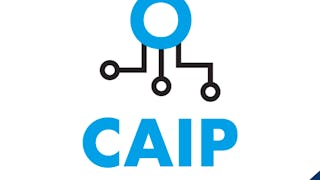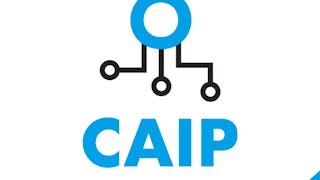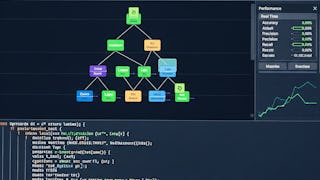There are numerous types of machine learning algorithms, each of which has certain characteristics that might make it more or less suitable for solving a particular problem. Decision trees and support-vector machines (SVMs) are two examples of algorithms that can both solve regression and classification problems, but which have different applications. Likewise, a more advanced approach to machine learning, called deep learning, uses artificial neural networks (ANNs) to solve these types of problems and more. Adding all of these algorithms to your skillset is crucial for selecting the best tool for the job.


Build Decision Trees, SVMs, and Artificial Neural Networks
This course is part of CertNexus Certified Artificial Intelligence Practitioner Professional Certificate

Instructor: Stacey McBrine
4,675 already enrolled
Included with
(14 reviews)
Recommended experience
What you'll learn
Train and evaluate decision trees and random forests for regression and classification.
Train and evaluate support-vector machines (SVM) for regression and classification.
Train and evaluate multi-layer perceptron (ML) artificial neural networks (ANN) for regression and classification.
Train and evaluate convolutional neural networks (CNN) and recurrent neural networks (RNN) for computer vision and natural language processing tasks.
Skills you'll gain
- Decision Tree Learning
- Recurrent Neural Networks (RNNs)
- Predictive Modeling
- Classification Algorithms
- Artificial Intelligence and Machine Learning (AI/ML)
- Random Forest Algorithm
- Machine Learning Algorithms
- Convolutional Neural Networks
- Applied Machine Learning
- Deep Learning
- Artificial Neural Networks
- Supervised Learning
- Computer Vision
- Natural Language Processing
Details to know

Add to your LinkedIn profile
See how employees at top companies are mastering in-demand skills

Build your Machine Learning expertise
- Learn new concepts from industry experts
- Gain a foundational understanding of a subject or tool
- Develop job-relevant skills with hands-on projects
- Earn a shareable career certificate from CertNexus

There are 5 modules in this course
You've built machine learning models from fundamental linear regression and classification algorithms. These algorithms can get you pretty far in many scenarios, but they are not the only algorithms that can meet your needs. In this module, you'll build machine learning models from decision trees and random forests, two alternative approaches to solving regression and classification problems.
What's included
16 videos5 readings1 assignment1 discussion prompt2 ungraded labs
Another alternative approach to regression and classification comes in the form of support-vector machines (SVMs). In this module, you'll build SVMs that can do a good job of handling outliers and tackling high-dimensional data in an efficient manner.
What's included
8 videos3 readings1 assignment1 discussion prompt2 ungraded labs
All of the algorithms discussed thus far fall under the general umbrella of machine learning. While they are powerful and complex in their own right, the algorithms that make up the subdomain of deep learning—called artificial neural networks (ANNs)—are even more so. In this module, you'll build a fundamental version of an ANN called a multi-layer perceptron (MLP) that can tackle the same basic types of tasks (regression, classification, etc.), while being better suited to solving more complicated and data-rich problems.
What's included
8 videos2 readings1 assignment1 discussion prompt1 ungraded lab
Now that you've built MLP neural networks, you can incorporate them into two wider architectures: convolutional neural networks (CNNs), which excel at solving computer vision problems; and recurrent neural networks (RNNs), which are most often used to process natural languages.
What's included
11 videos3 readings1 assignment1 discussion prompt2 ungraded labs
You'll work on a project in which you'll apply your knowledge of the material in this course to a practical scenario.
What's included
1 peer review1 ungraded lab
Earn a career certificate
Add this credential to your LinkedIn profile, resume, or CV. Share it on social media and in your performance review.
Instructor

Offered by
Explore more from Machine Learning
 Status: Free Trial
Status: Free Trial Status: Free Trial
Status: Free Trial Status: Preview
Status: Preview Status: Preview
Status: Preview
Why people choose Coursera for their career




Learner reviews
14 reviews
- 5 stars
92.85%
- 4 stars
7.14%
- 3 stars
0%
- 2 stars
0%
- 1 star
0%
Showing 3 of 14
Reviewed on Feb 11, 2023
This was a very intense course. I am glad I was able to see it through to the end

Open new doors with Coursera Plus
Unlimited access to 10,000+ world-class courses, hands-on projects, and job-ready certificate programs - all included in your subscription
Advance your career with an online degree
Earn a degree from world-class universities - 100% online
Join over 3,400 global companies that choose Coursera for Business
Upskill your employees to excel in the digital economy
Frequently asked questions
To access the course materials, assignments and to earn a Certificate, you will need to purchase the Certificate experience when you enroll in a course. You can try a Free Trial instead, or apply for Financial Aid. The course may offer 'Full Course, No Certificate' instead. This option lets you see all course materials, submit required assessments, and get a final grade. This also means that you will not be able to purchase a Certificate experience.
When you enroll in the course, you get access to all of the courses in the Certificate, and you earn a certificate when you complete the work. Your electronic Certificate will be added to your Accomplishments page - from there, you can print your Certificate or add it to your LinkedIn profile.
More questions
Financial aid available,
¹ Some assignments in this course are AI-graded. For these assignments, your data will be used in accordance with Coursera's Privacy Notice.

